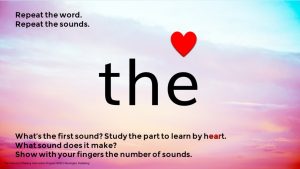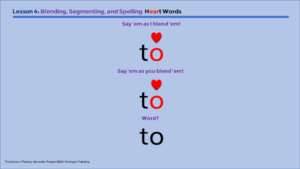How to Teach Heart Words

How to Teach Heart Words
Want to watch how I teach two Heart Words to older reading intervention students and lead them in guided practice? Check out my “real-time” (7:52) lesson on YouTube! https://www.youtube.com/watch?v=ssa5S7Qq6sA
English often is referred to as a difficult language to learn to speak, read, and spell because of its irregular sound-spellings. However, contrary to this assumption, the English orthographic system is actually quite regular and reliable. Of course, there are exceptions, but not as many as teachers generally think.
One helpful development from the Science of Reading movement has been the refinement of some reading instructional terminology. One such term that has come to some degree of consensus is Heart Words. A Heart Word is usually defined as a word with one or more irregular sound-spellings. One important point should be emphasized: In Heart Words, the whole word is not phonetically irregular; only a part or parts is irregular. In other words, “the parts to learn by heart.”
On the Reading Rockets website, Linda Farrell and Michael Hunter summarize their helpful study on the Dolch 220 list of high frequency words. Of the 220 words, 82 were identified as Heart Words (37%). https://www.readingrockets.org/article/new-model-teaching-high-frequency-words
Noted reading researcher, David Kilpatrick (2015), comments that “the vast majority of irregular words have only a single irregular letter-sound relationship.”
Now there is some disagreement regarding the scope of Heart Words.
- Some reading specialists assert that Heart Words should only be called such until the word has orthographically mapped–hardwired in the brain.
- Some would limit the Heart Word designation to words on the high frequency Dolch or Fry list.
- Some would limit the heart designation to one per syllable. In other words, in the word of only one heart would be displayed underneath the two letters (usually designated by a line underneath them or color-coded boxes. I display one heart for the “o” and one for the “f,” because both of the two sound-spellings are irregular. Thus, the Heart Word of has two parts to learn by heart by my way of thinking.
- Some disagree about what constitutes an irregular sound-spelling. We all know some colleagues who consider a sound-spelling to be regular if some sort of rare rule or mnemonic can be applied, even to a limited number of words. Thus, for example, they would argue that would, could, should should not be classified as Heart Words.
- Some speech to print reading specialists add more spellings to sounds and avoid the Heart Words designation altogether. Thus, they would teach the “e” spelling in pretty as another short /i/ option.
- Some would exclude silent letters from the Heart Words designation, for example the “w” in answer. Now most would treat the VCe as a non-Heart Word if the vowel is a long sound e.g., ate, but as a Heart Word if the vowel sound is short or a diphthong e.g. gone or route.
 1. Segmenting: Say It! We start with the sounds. I use my first Google slide to display the focus Heart Word. I say the word, using continuous blending. In other words, I read through the word, adjusting pronunciation according to stop and continuous sounds. I direct students to look at the word and repeat it as I blend it.
1. Segmenting: Say It! We start with the sounds. I use my first Google slide to display the focus Heart Word. I say the word, using continuous blending. In other words, I read through the word, adjusting pronunciation according to stop and continuous sounds. I direct students to look at the word and repeat it as I blend it.
Next, we segment each of the sounds out loud. I target the Heart Word sound-spelling by saying, “Study the part to learn by heart.” Afterword, I direct students: “Show with your fingers the number of sounds.” I prompt students to tap their knees to count the number of phonemes. I display my second slide with the answer and the Heart Word (without the heart(s)) in a variety of fonts.
second slide with the answer and the Heart Word (without the heart(s)) in a variety of fonts.
 2. Spelling: Spell It! Have students spell the word before they read it. I display my third slide and direct students to say each sound as they spell them, using the squiggle tool with Google slides (or pencil if using print copies). I use proper letter formation models for both the slides and print copies. Handwriting is important!
2. Spelling: Spell It! Have students spell the word before they read it. I display my third slide and direct students to say each sound as they spell them, using the squiggle tool with Google slides (or pencil if using print copies). I use proper letter formation models for both the slides and print copies. Handwriting is important!
 3. Blending: Read It! Say ’em as I blend ’em! Say ’em as you blend ’em! Word? For each lesson, I’ve chosen two of my list of 108 high frequency Heart Words. I use my fourth slide to show one of the two focus Heart Words, which is printed three times. I slide my hand under the first on the display or screen and blend with students. For the second, students blend out loud on their own, sliding their hand on their Google slide tablet screens or in the air. For the third (without the heart(s), I point to and ask, “Word?”
3. Blending: Read It! Say ’em as I blend ’em! Say ’em as you blend ’em! Word? For each lesson, I’ve chosen two of my list of 108 high frequency Heart Words. I use my fourth slide to show one of the two focus Heart Words, which is printed three times. I slide my hand under the first on the display or screen and blend with students. For the second, students blend out loud on their own, sliding their hand on their Google slide tablet screens or in the air. For the third (without the heart(s), I point to and ask, “Word?”
 Next, I display my fifth slide, which shows three Heart Words with the same part(s) to learn by heart as our focus Heart Word. We blend each word and I ask students to explain how these words are similar to lesson’s Heart Word. Even though Heart Words have an irregular sound-spelling (or a few), most have similar patterns as other Heart Words. Extend the learning! English has patterns even with irregular sound-spellings.
Next, I display my fifth slide, which shows three Heart Words with the same part(s) to learn by heart as our focus Heart Word. We blend each word and I ask students to explain how these words are similar to lesson’s Heart Word. Even though Heart Words have an irregular sound-spelling (or a few), most have similar patterns as other Heart Words. Extend the learning! English has patterns even with irregular sound-spellings.
4. Heart Words Guided Practice: After the explicit Segmenting-Spelling-Blending instruction, students complete guided practice. Students sort similar or comparable irregular sound-spellings to match the two focus Heart Words and open up doors on the Google slide to check their answers. Next, students identify the “parts to learn by heart” with similar or comparable Heart Words by dragging and dropping the hearts above the phonetically irregular sound-spellings (or they draw the hearts if using print copies).
guided practice. Students sort similar or comparable irregular sound-spellings to match the two focus Heart Words and open up doors on the Google slide to check their answers. Next, students identify the “parts to learn by heart” with similar or comparable Heart Words by dragging and dropping the hearts above the phonetically irregular sound-spellings (or they draw the hearts if using print copies).

Sam and Friends Phonics Books
5. Decodable Practice: In my 54 decodables, the Sam and Friends Phonics Books, each story includes plenty of practice in the lesson’s focus regular sound-spelling patterns and the two Heart Words. Plus, the back page includes a 30-second Word Fluency with built-in timer to practice these words and record the number of words read per timing.
6. Heart Words Assessment: In the second half of my full-year reading intervention program, I provide mid-year diagnostic assessments. One of the assessments tests mastery of the 108 high frequency Heart Words. This assessment will pinpoint the Heart Words that students cannot yet read and spell accurately. “If they know it, this (assessment) will show it; if they don’t, it won’t.” The assessment provides the data for teachers to differentiate instruction.
Want to watch how I teach two Heart Words to older reading intervention students and lead them in guided practice? Check out my “real-time” (7:52) lesson on YouTube! https://www.youtube.com/watch?v=ssa5S7Qq6sA

The Science of Reading Intervention Program
The Science of Reading Intervention Program: Word Recognition includes explicit, scripted instruction and practice with the 6 Daily Google Slide Activities every reading intervention student needs: 1. Phonemic Awareness 2. Segmenting, Spelling, and Blending 3. Sounds and Spellings Guided Practice (including handwriting) 4. Word Chains 5. Sam and Friends Phonics Books (decodables). 6 . Elkonin Sound Boxes and digital and printable sound wall cards and speech articulation songs. Print versions are available for all activities. First Half of the Year Program (55 minutes-per-day, 18 weeks)
The Science of Reading Intervention Program: Language Comprehension resources are designed for students who have completed the word recognition program or have demonstrated basic mastery of the alphabetic code and can read with some degree of fluency. The program features the 5Weekly Language Comprehension Activities: 1. Background Knowledge Mentor Texts 2. Academic Language, Greek and Latin Morphology, Figures of Speech, Connotations, Multiple Meaning Words 3. Syntax in Reading 4. Reading Comprehension Strategies 5. Literacy Knowledge (Narrative and Expository). Second Half of the Year Program (30 minutes-per-day, 18 weeks)
The Science of Reading Intervention Program: Assessment-based Instruction provides diagnostically-based “second chance” instructional resources. The program includes 13 comprehensive assessments and matching instructional resources to fill in the yet-to-be-mastered gaps in phonemic awareness, alphabetic awareness, phonics, fluency (with YouTube modeled readings), Heart Words and Phonics Games, spelling patterns, grammar, usage, and mechanics, syllabication and morphology, executive function shills. Second Half of the Year Program (25 minutes-per-day, 18 weeks)
The Science of Reading Intervention Program BUNDLE includes all 3 program components for the comprehensive, state-of-the-art (and science) grades 4-adult full-year program. Scripted, easy-to-teach, no prep, no need for time-consuming (albeit valuable) LETRS training or O-G certification… Learn as you teach and get results NOW for your students. Print to speech with plenty of speech to print instructional components.